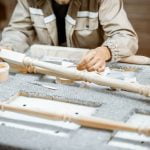Are you a woodworker looking to build your own workbench? One of the most crucial decisions you’ll make is selecting the right type of wood for your project.
The type of wood you choose will impact the durability, workability, and overall aesthetics of your woodworkers bench. In this article, we will delve into the different types of wood suitable for woodworkers benches, factors to consider when selecting wood, and how to treat and finish the wood for a long-lasting bench.
When it comes to choosing the right wood for a woodworkers bench, there are several factors to take into consideration. From durability and density to workability and aesthetic appeal, it’s important to understand how each type of wood can impact the functionality and overall look of your bench. Whether you opt for hardwoods or softwoods, each type has its own set of characteristics that make it suitable for woodworking projects.
In the following sections, we will explore various types of hardwoods such as oak, maple, and birch, as well as softwoods like pine, cedar, and spruce that are commonly used for building woodworkers benches. Additionally, we will discuss how grain structure and color can impact the aesthetics of your bench. By understanding these aspects, you can make an informed decision when selecting the right wood for your woodworking project.
Types of Wood Suitable for Woodworkers Benches
When it comes to choosing the right wood for your woodworkers bench, it’s essential to understand the difference between hardwoods and softwoods. Each type of wood has its own set of characteristics, making them suitable for different woodworking projects.
Hardwoods are known for their durability, strength, and resistance to wear and tear, making them a popular choice for woodworkers benches. Some common hardwood options for benches include oak, maple, and birch. These woods are dense and have a tight grain structure, making them ideal for heavy-duty use in a workshop setting.
On the other hand, softwoods such as pine, cedar, and spruce are more affordable and readily available. While they may not be as durable as hardwoods, they are still a viable option for woodworkers benches, especially if cost is a factor. Softwoods are easier to work with due to their softer nature, making them suitable for beginners or DIY enthusiasts.
When deciding between hardwoods and softwoods for your woodworkers bench, it’s important to consider factors such as durability, density, and workability. Hardwoods are typically more durable and dense than softwoods, but they can also be more difficult to work with due to their hardness. Softwoods may not be as durable but are easier to manipulate during the construction process.
Choosing the Right Hardwood for Your Woodworkers Bench
Oak: A Durable and Popular Choice
When it comes to choosing the right hardwood for your woodworkers bench, oak is often a popular choice among woodworkers. Known for its durability and strength, oak can withstand heavy use and has natural resistance to moisture, making it an ideal option for a workbench.
Additionally, oak has a beautiful grain pattern that adds to the overall aesthetic appeal of the bench. While red oak is more commonly used due to its affordability, white oak is also a great option for those willing to invest a bit more in their workbench.
Maple: A Hardwood With Excellent Workability
Another hardwood option for a woodworkers bench is maple. Maple is prized for its fine, consistent grain pattern and light color, which can give the bench a clean and classic look. This hardwood is known for its excellent workability, making it easier to carve and shape into the desired form.
It also has good stability and strength, making it suitable for heavy-duty woodworking tasks. While hard maple is more expensive than soft maple, both varieties are good options depending on budget and preference.
Birch: A Cost-Effective Option With Great Durability
For those looking for a cost-effective yet durable hardwood option for their woodworkers bench, birch is worth considering. Birch has a straight grain and even texture, giving it a smooth appearance when finished. It’s known for being strong and resilient, making it suitable for heavy use in a workshop setting. While not as common as oak or maple for workbenches, birch provides good value without compromising on quality.
By considering factors such as durability, workability, and budget, woodworkers can make an informed decision when choosing between these hardwood options for their next bench project. Whether opting for the classic beauty of oak or the workability of maple or birch, selecting the right hardwood will ensure that the woodworkers bench meets both functional and aesthetic requirements.
Exploring Softwood Options
When it comes to choosing the right wood for your woodworkers bench, softwoods can be a great option for those on a budget or looking for a lighter-weight bench. While not as durable as hardwoods, softwoods like pine, cedar, and spruce have their own unique advantages that make them suitable for woodworking projects.
Here are some of the key benefits of using softwood for your woodworkers bench:
- Affordability: Softwoods are generally more affordable than hardwoods, making them a great option for those who are working within a budget. This means you can still create a high-quality woodworkers bench without breaking the bank.
- Lightweight: Softwoods are significantly lighter than most hardwoods, making them easier to work with and transport. This can be especially beneficial if you need to move your bench around frequently or if you want to build a portable workbench.
- Aesthetic Appeal: Softwoods often have a more natural and rustic look, with beautiful grain patterns and warm color variations. This can add character to your woodworkers bench and create a visually appealing workspace.
When selecting softwood for your woodworkers bench, it’s important to consider the specific characteristics of each type of wood. Pine is known for its affordability and ease of workability, while cedar offers natural resistance to decay and insects. Spruce is valued for its strength-to-weight ratio and straight grain pattern.
Overall, softwoods can be an excellent choice for crafting a functional and attractive woodworkers bench while considering factors such as cost, weight, and aesthetic appeal.
Factors to Consider When Selecting Wood for a Woodworkers Bench
When it comes to selecting the right wood for your woodworker’s bench, there are several important factors to consider. One of the most crucial considerations is the durability of the wood. Since a woodworker’s bench is a piece of equipment that will see a lot of use and potentially heavy loads, it is essential to choose a wood that can withstand this kind of wear and tear.
Additionally, the density of the wood is important as well. A denser wood will be more resistant to dents and scratches, making it a better choice for a work surface that will be subjected to various tools and materials.
In addition to durability and density, workability is another key factor to consider when selecting wood for a woodworker’s bench. Workability refers to how easily the wood can be shaped, cut, and joined together.
This is important because woodworking often involves cutting and shaping pieces of wood, so it’s essential to choose a type of wood that cooperates well with these processes. So, when deciding what kind of wood to make a woodworkers bench out of, it’s important to prioritize both workability in addition to durability.
Overall, finding the right balance between durability, density, and workability is essential in choosing the best type of wood for your project. Different types of woods offer varying combinations of these qualities, so it’s important for each individual woodworker to weigh their specific needs before making a decision on which type of wood is most suitable for their project.
The Impact of Grain Structure and Color on the Aesthetics of a Woodworkers Bench
When it comes to building a woodworkers bench, the choice of wood goes beyond just considering its durability and workability. The aesthetics of the bench are also an important factor to take into account. The impact of grain structure and color on the overall look of the bench cannot be overstated.
The grain structure of the wood refers to the pattern created by the arrangement of its fibers. This can have a significant impact on the appearance of the woodworkers bench. For example, woods with a straight grain, such as maple or birch, can give a more uniform and sleek look to the bench, while those with a more pronounced grain, like oak, can add character and visual interest to the piece.
In addition to grain structure, the color of the wood is another important aesthetic consideration. Different types of wood offer a wide range of color options, from light blondes to deep reds and browns. Some species even have natural variations in color within the same piece of wood, adding further visual appeal to the bench.
Consideration must also be given to how different finishes will enhance or alter these natural features of the wood. Stains and varnishes can deepen or change the color while still allowing for grain appreciation.
It is important for woodworkers to carefully consider both grain structure and color when selecting the type of wood for their benches in order to achieve not only functionality but also an aesthetically pleasing result.
| Aspect | Impact |
|---|---|
| Grain Structure | Affects appearance – straight grain for uniformity, pronounced grains for character |
| Color | Different options – light blondes to deep reds/browns – adds visual appeal |
| Finishes | Can alter color while highlighting natural features like grain patterns |
How to Treat and Finish the Wood for a Long-Lasting Woodworkers Bench
Choosing the Right Finish for Your Woodworkers Bench
When it comes to treating and finishing the wood for a long-lasting woodworkers bench, there are several options to consider. One popular choice is applying a natural oil finish, such as linseed oil or tung oil. These finishes penetrate the wood, enhancing its natural beauty while providing protection against moisture and everyday wear and tear.
Another option is using a sealant or varnish, which creates a protective barrier on the surface of the wood. It’s important to choose a finish that suits your preference in terms of appearance and maintenance.
Applying the Finish
Once you’ve selected the right finish for your woodworkers bench, it’s crucial to apply it correctly for optimal results. Start by sanding the wood to create a smooth surface, then use a clean cloth or brush to apply the finish in even strokes along the grain of the wood.
Allow the first coat to dry completely before applying additional coats as needed. Depending on the type of finish you choose, you may also need to apply a topcoat or wax for added protection and durability.
Maintaining Your Finished Woodworkers Bench
To ensure that your woodworkers bench remains long-lasting and beautiful, proper maintenance is key. Regular cleaning with a mild soap and water solution will help remove dirt and grime without damaging the finish. Avoid using harsh chemicals or abrasive cleaners, as these can wear down the finish over time. Additionally, consider reapplying a fresh coat of finish every few years to keep your woodworkers bench looking its best and protected from daily use.
By carefully selecting an appropriate finish and maintaining it properly, you can enjoy a long-lasting woodworkers bench that not only serves as a functional workspace but also adds aesthetic appeal to your woodworking area.
Budget-Friendly Options for Woodworkers Benches
When it comes to building a woodworkers bench, one of the most important considerations is the type of wood to use. While hardwoods like oak, maple, and birch are popular choices for their durability and strength, they can also come with a high price tag. However, there are budget-friendly options available that allow you to find affordable wood without sacrificing quality for your woodworking project.
One budget-friendly option for woodworkers benches is using softwoods such as pine, cedar, and spruce. These woods are generally more affordable than hardwoods and can still provide a sturdy and reliable work surface for your woodworking projects. While softwoods may not have the same level of hardness as hardwoods, they can still be suitable for a woodworkers bench if properly treated and maintained.
Another way to find affordable wood for your woodworkers bench is by considering reclaimed or salvaged wood. Reclaimed wood can often be found at a lower cost than new lumber and offers the added benefit of being environmentally friendly by giving new life to old materials. Look for local salvage yards or online marketplaces to find reclaimed wood that can be used for your woodworking bench project.
In addition to considering the type of wood, it’s also important to factor in the overall cost of the project including tools, hardware, and finishes. By carefully planning and budgeting for your woodworkers bench project, you can find affordable wood options without compromising on quality or durability. With some research and creativity, you can create a high-quality woodworkers bench that fits within your budget constraints.
Final Thoughts
In conclusion, when it comes to deciding what kind of wood to make a woodworker’s bench out of, it is crucial to consider the specific needs and preferences of the individual woodworker. The choice between hardwoods and softwoods depends on factors such as durability, density, and workability.
Hardwoods like oak, maple, and birch offer exceptional strength and resistance to wear and tear, making them ideal for heavy-duty woodworking projects. On the other hand, softwoods such as pine, cedar, and spruce provide a more affordable option while still offering decent durability for lighter woodworking tasks.
In addition to considering the type of wood, woodworkers should also pay attention to the grain structure and color of the wood when choosing materials for their bench. These aesthetic elements can have a significant impact on the overall appearance of the bench and should be taken into account when making an informed decision.
Lastly, treating and finishing the wood properly is essential for ensuring the longevity of a woodworker’s bench. By applying protective coatings or oils, woodworkers can safeguard their benches against moisture, stains, and other forms of damage.
With careful consideration of all these factors, woodworkers can make well-informed decisions when selecting the right kind of wood for their bench project. Whether prioritizing durability, cost-effectiveness, or aesthetic appeal, there are numerous options available for creating a high-quality woodworker’s bench that meets individual needs and preferences.
Frequently Asked Questions
What Are Woodworking Benches Made Of?
Woodworking benches are typically made of solid wood, such as maple, oak, beech, or birch. These hardwoods are preferred because they are durable and provide a stable work surface for various woodworking tasks.
What Is the Best Material for a Workshop Bench?
The best material for a workshop bench is typically solid hardwood such as maple or beech. These woods are sturdy and can withstand the wear and tear of typical workshop use. Additionally, hardwoods provide a stable and smooth work surface for woodworking projects.
What Is the Best Wood Finish for a Woodworking Bench?
The best wood finish for a woodworking bench is often debated among woodworkers. Some prefer a simple oil finish to allow the natural beauty of the wood to shine through, while others opt for a more durable polyurethane finish to protect the bench from scratches and moisture.
Ultimately, the best wood finish depends on personal preference and how the bench will be used in the workshop.

Hi everyone! I’m a woodworker and blogger, and this is my woodworking blog. In my blog, I share tips and tricks for woodworkers of all skill levels, as well as project ideas that you can try yourself.





